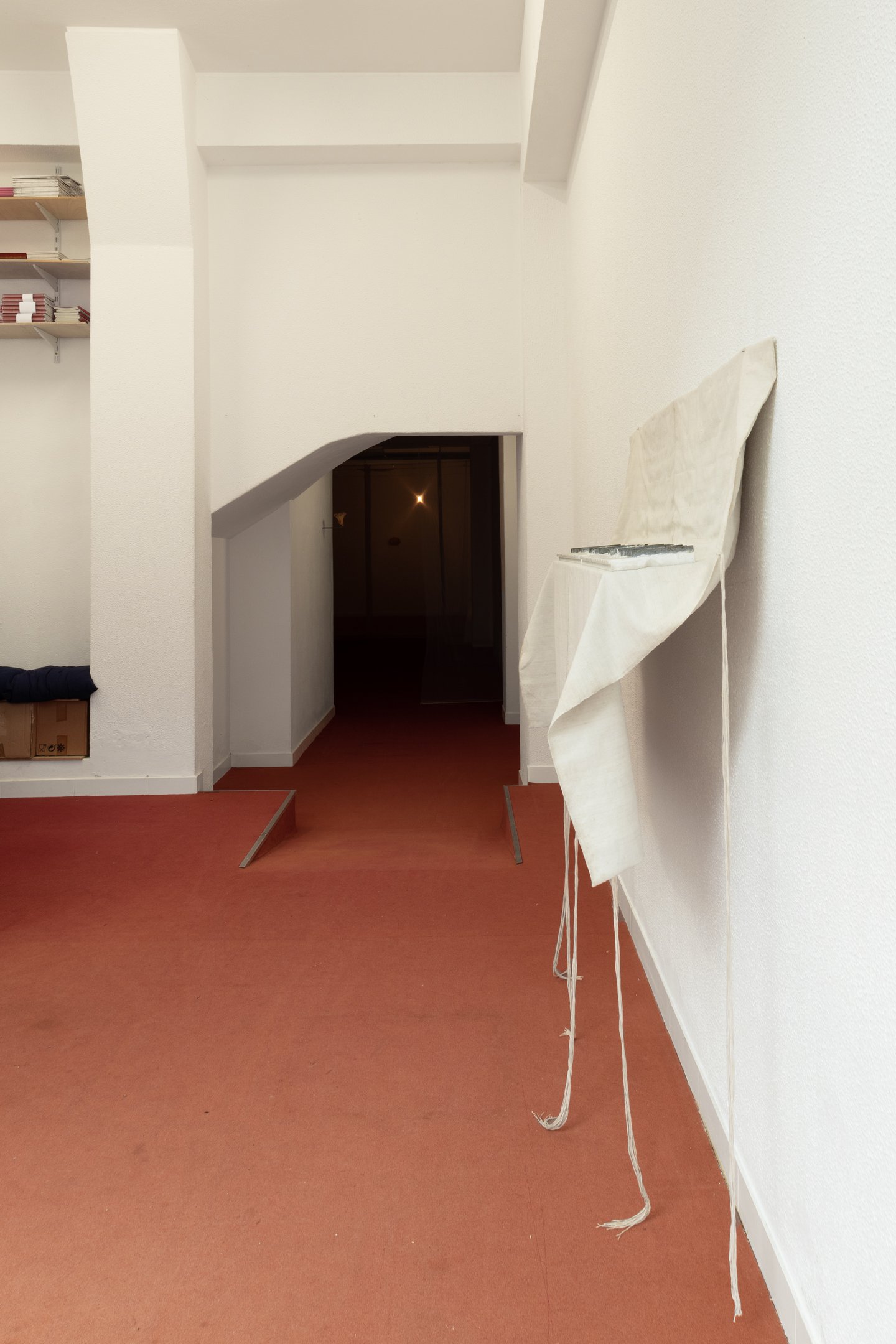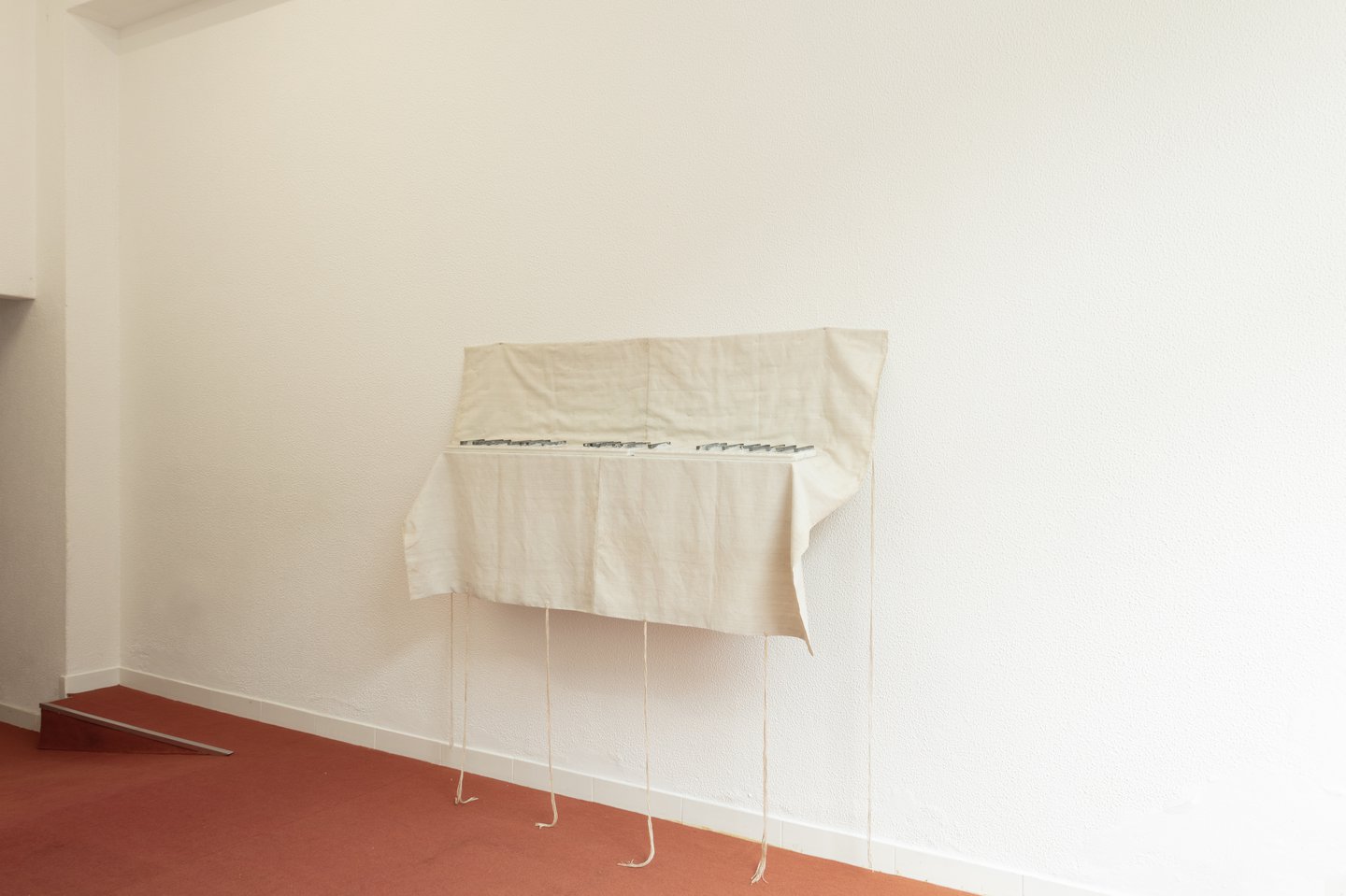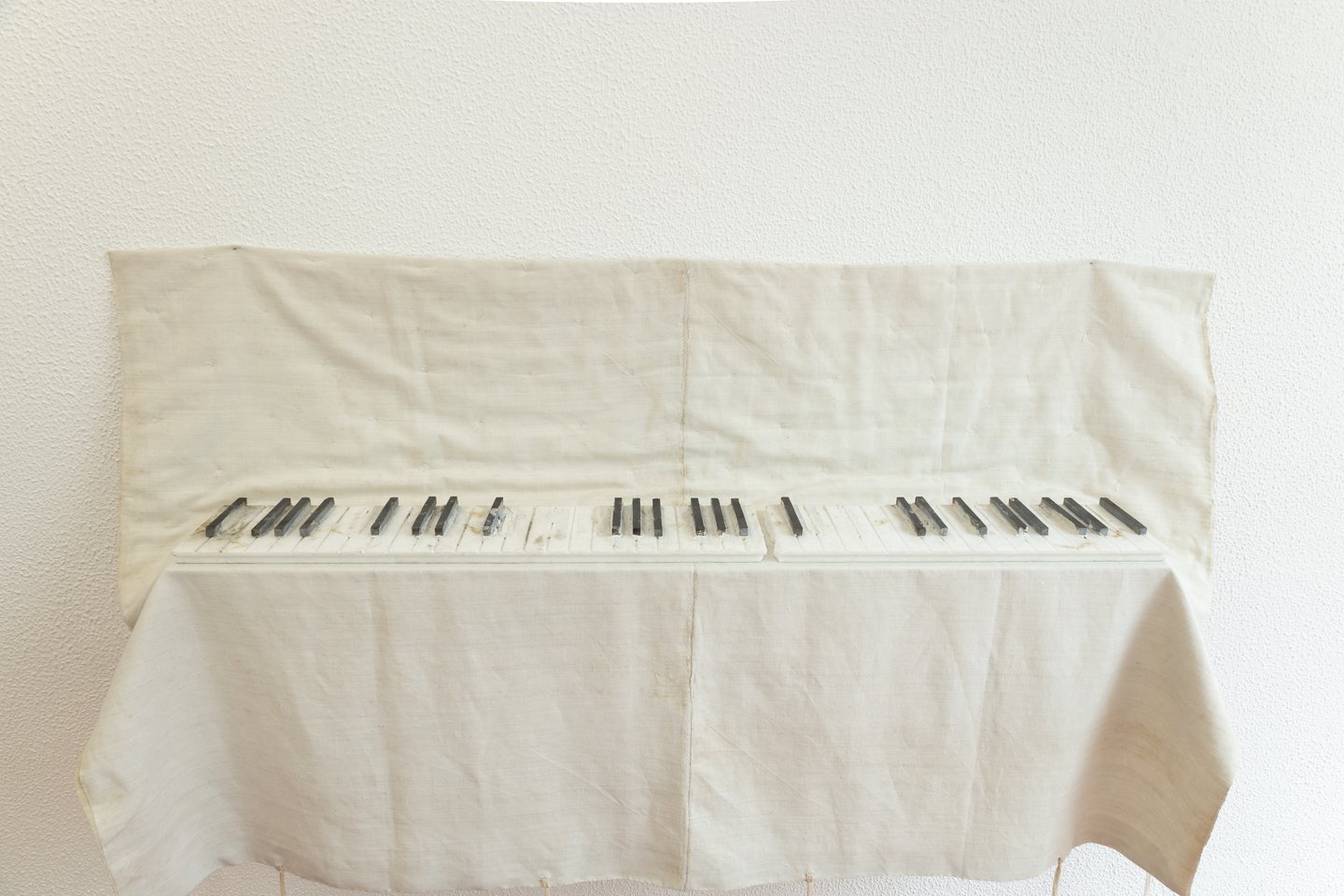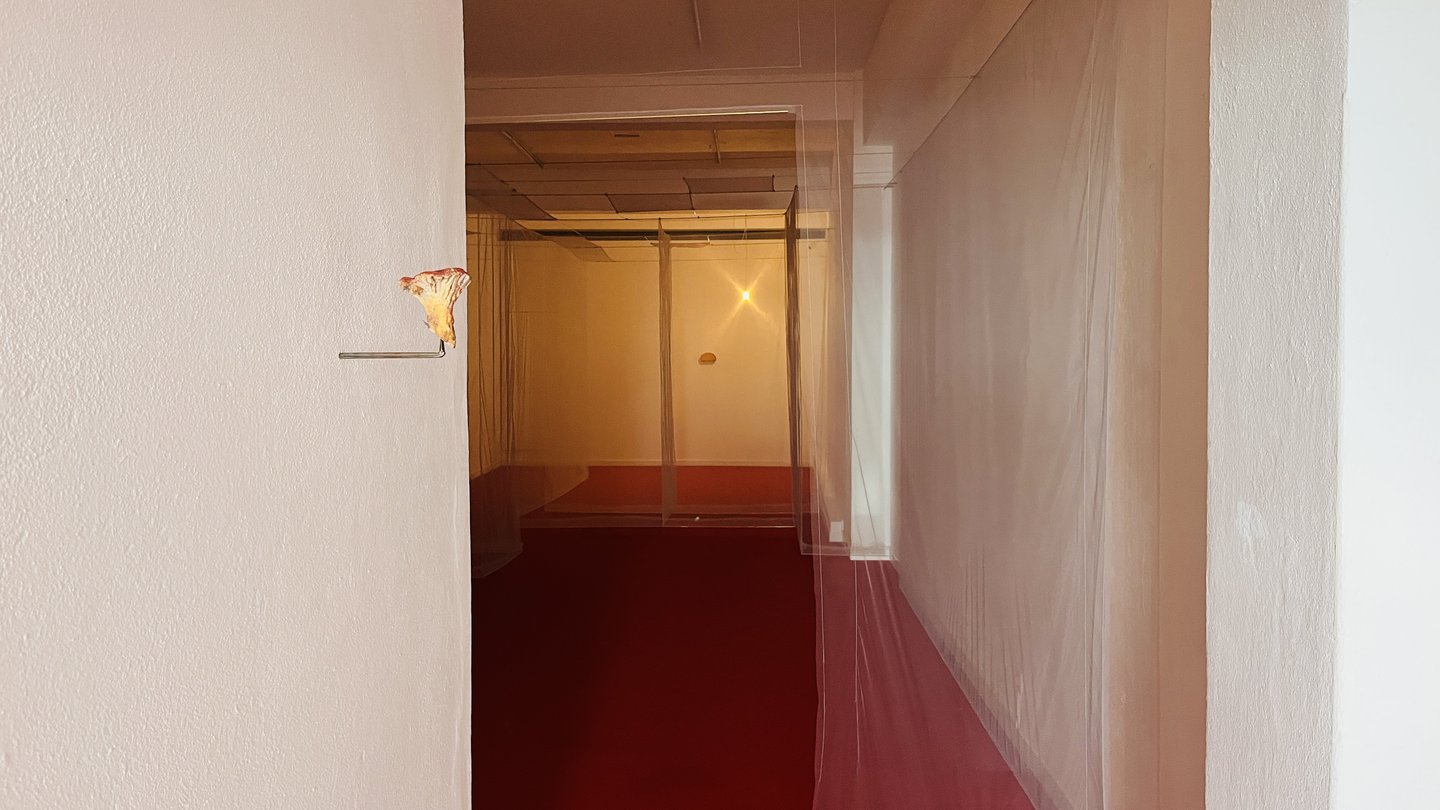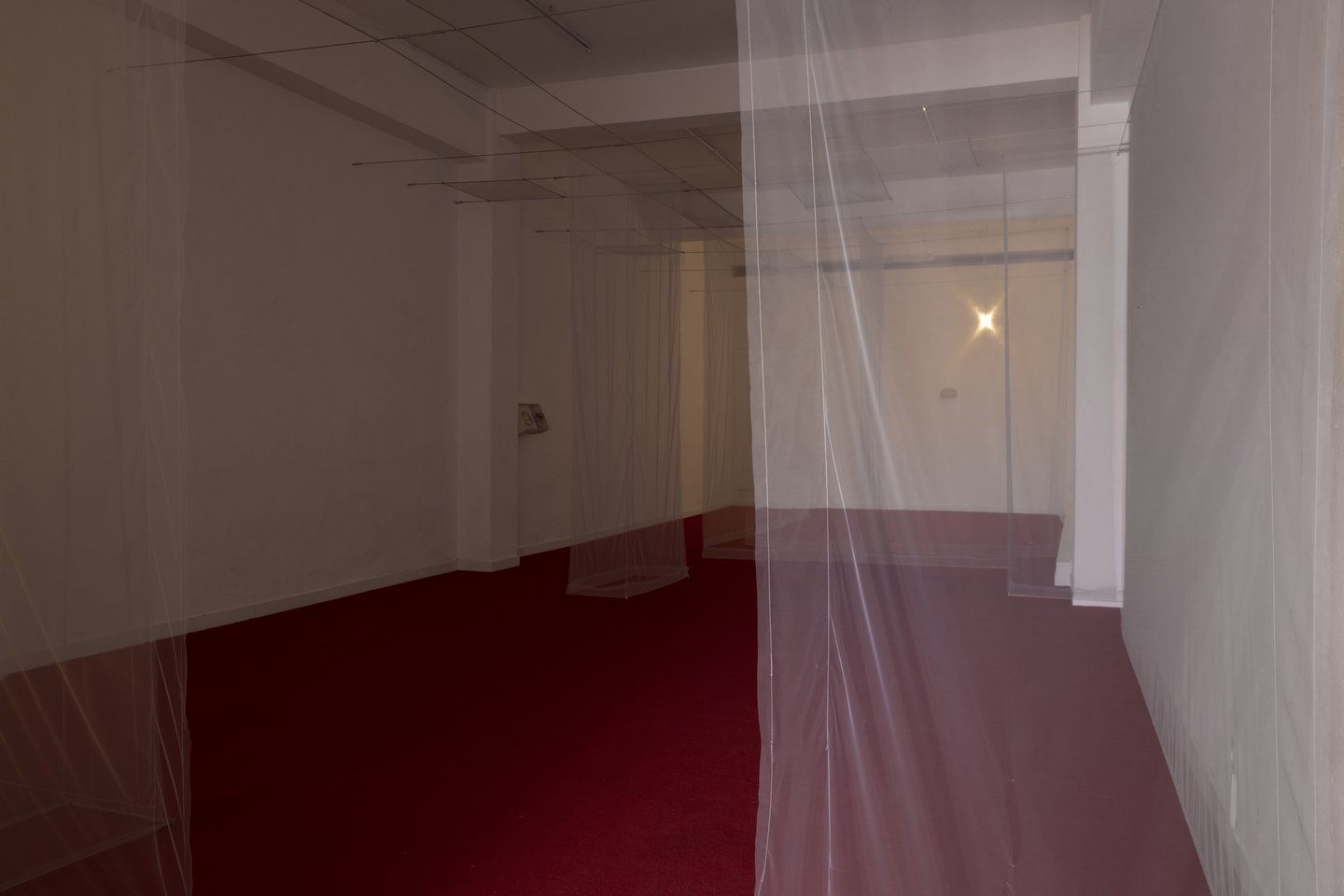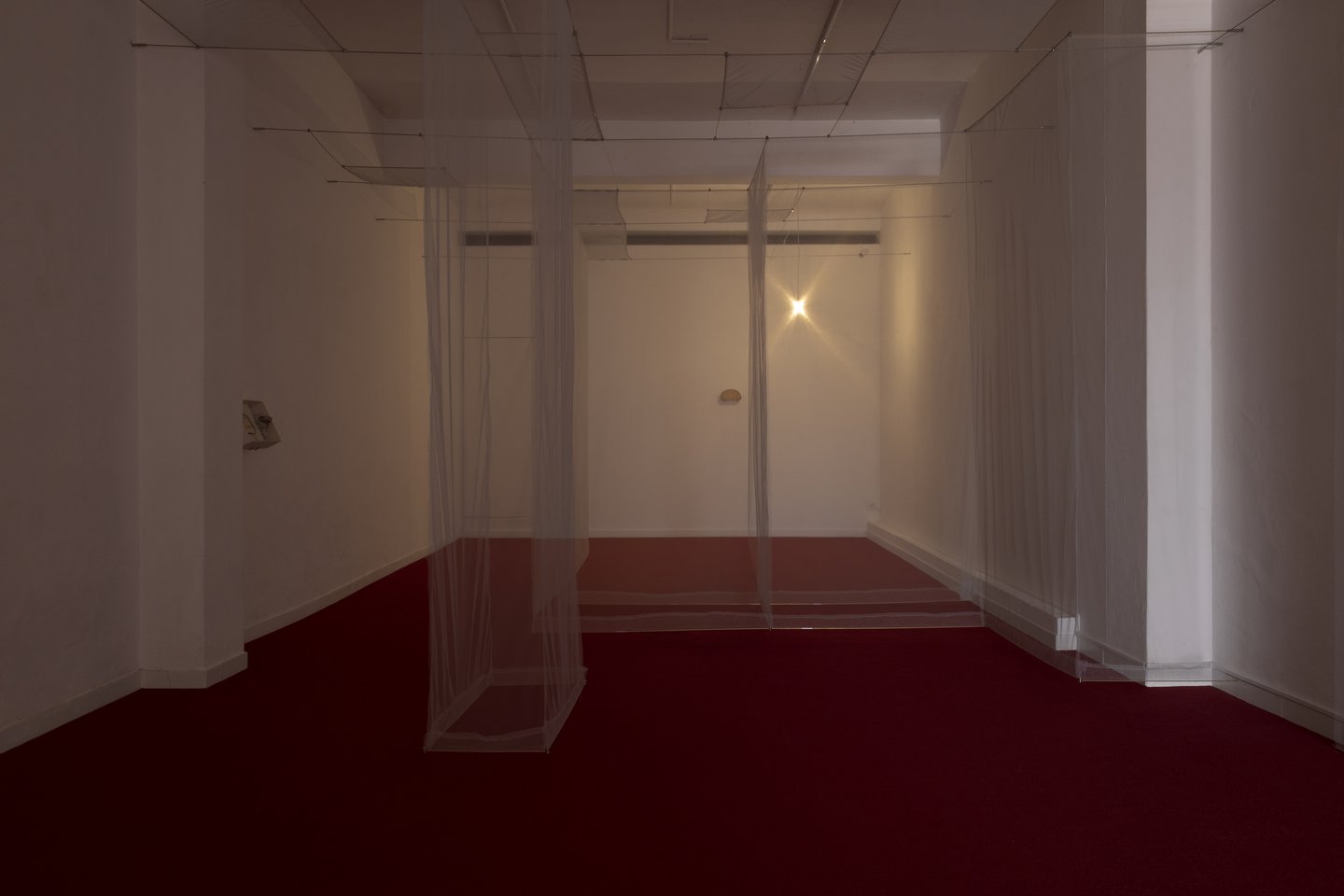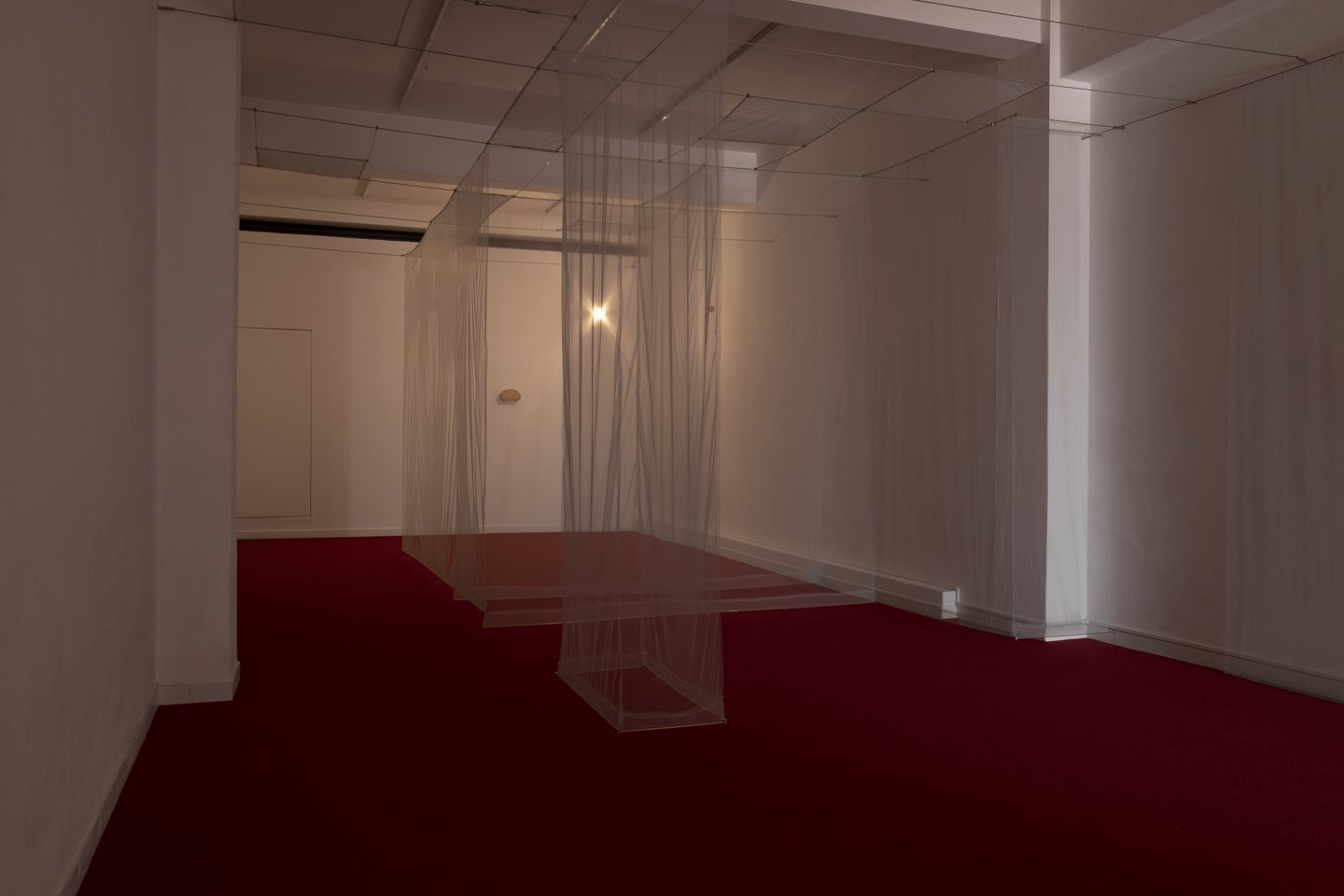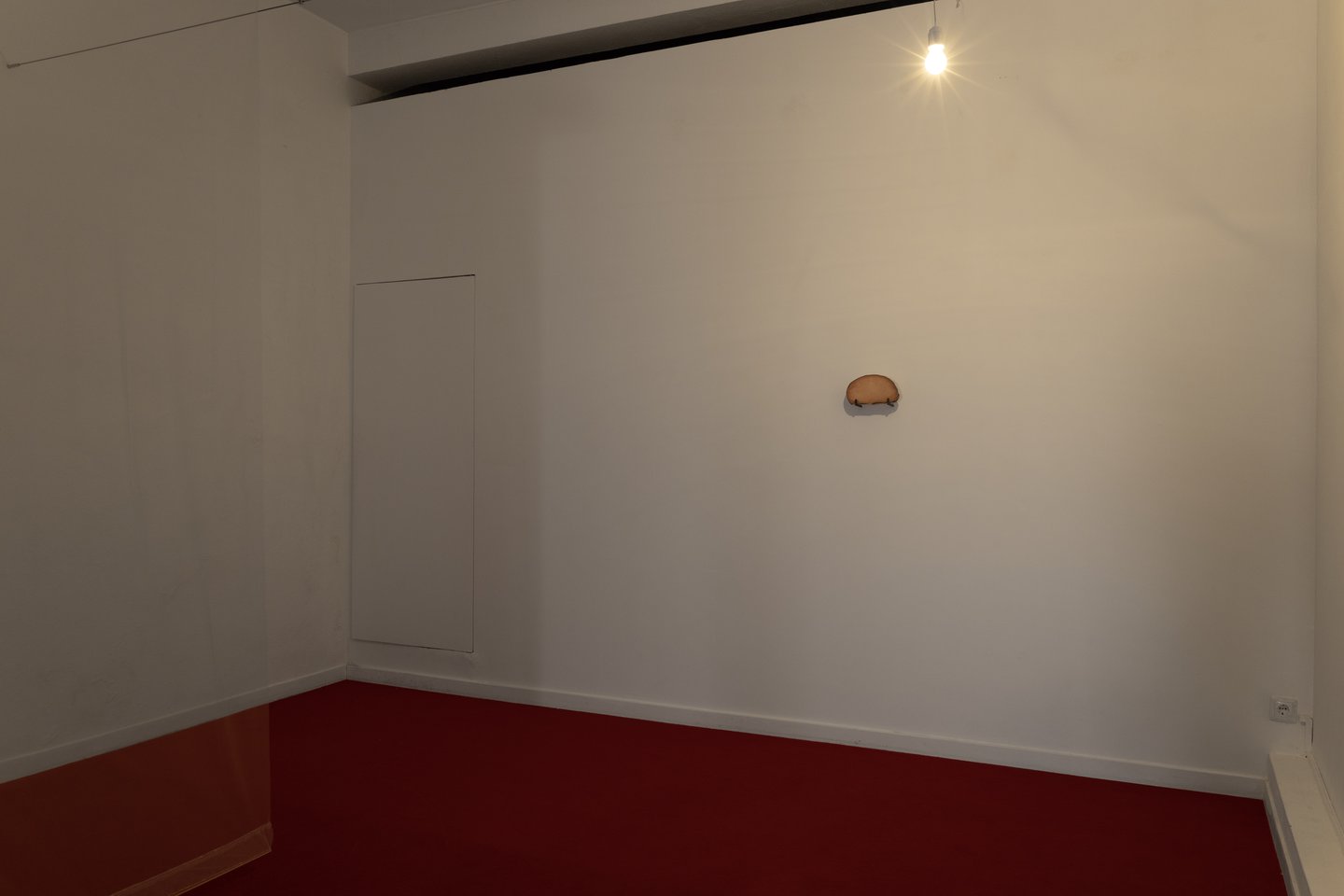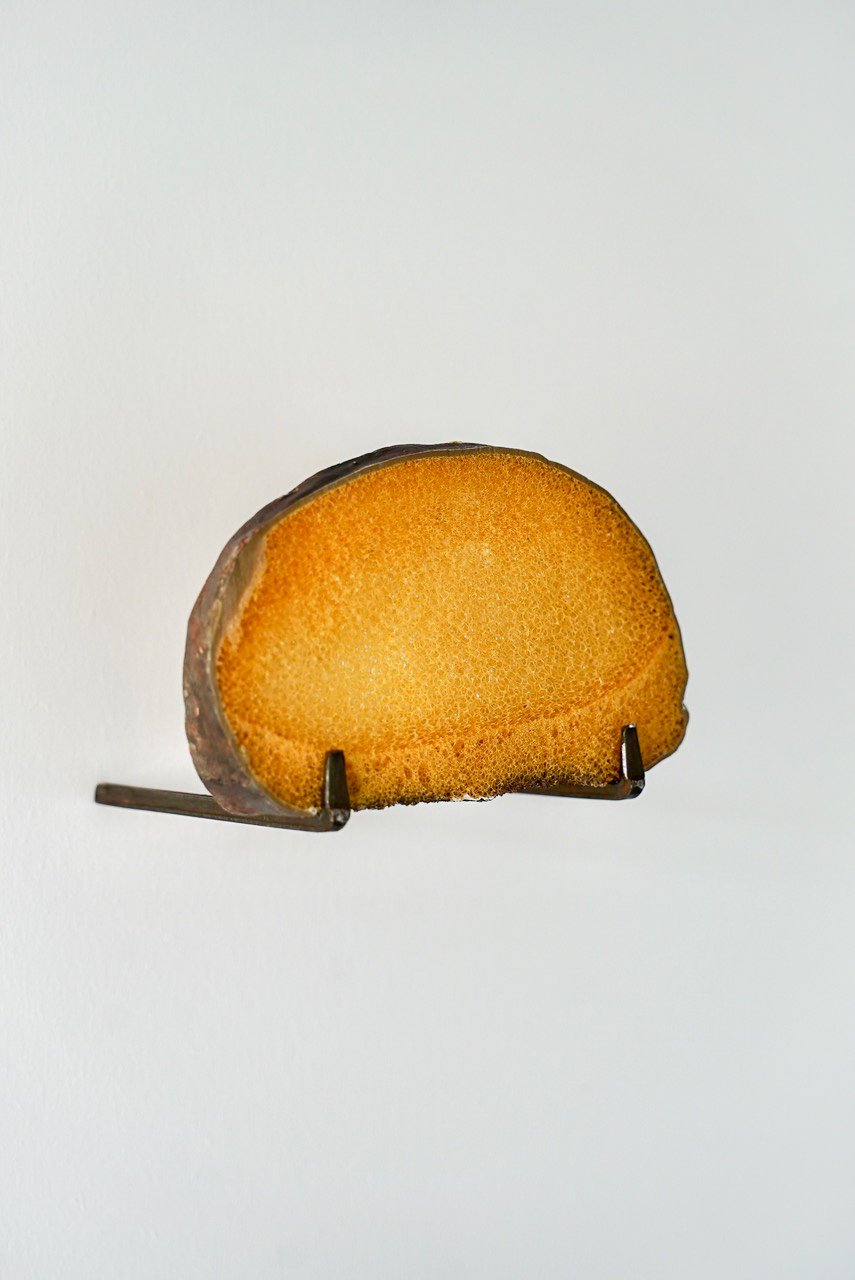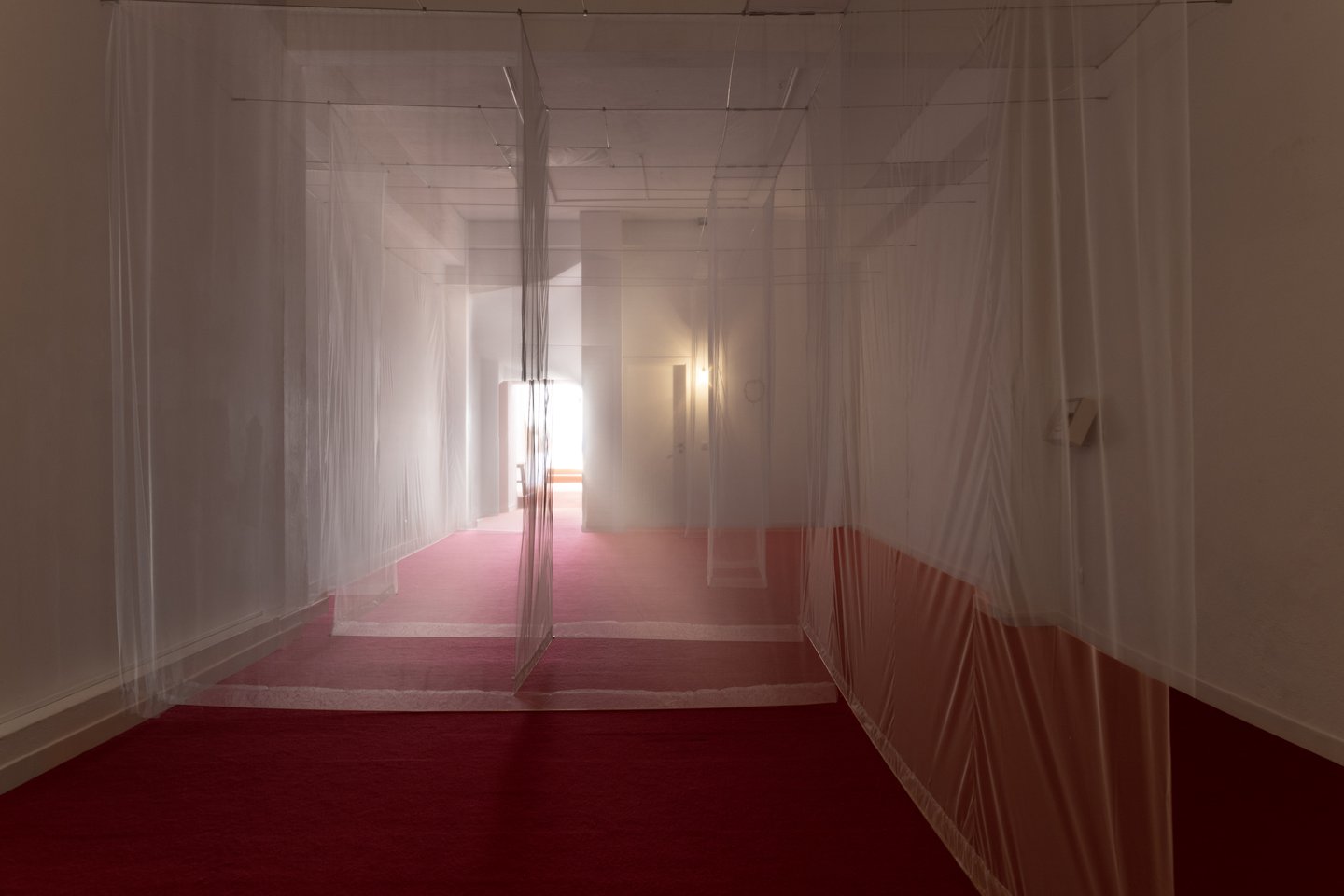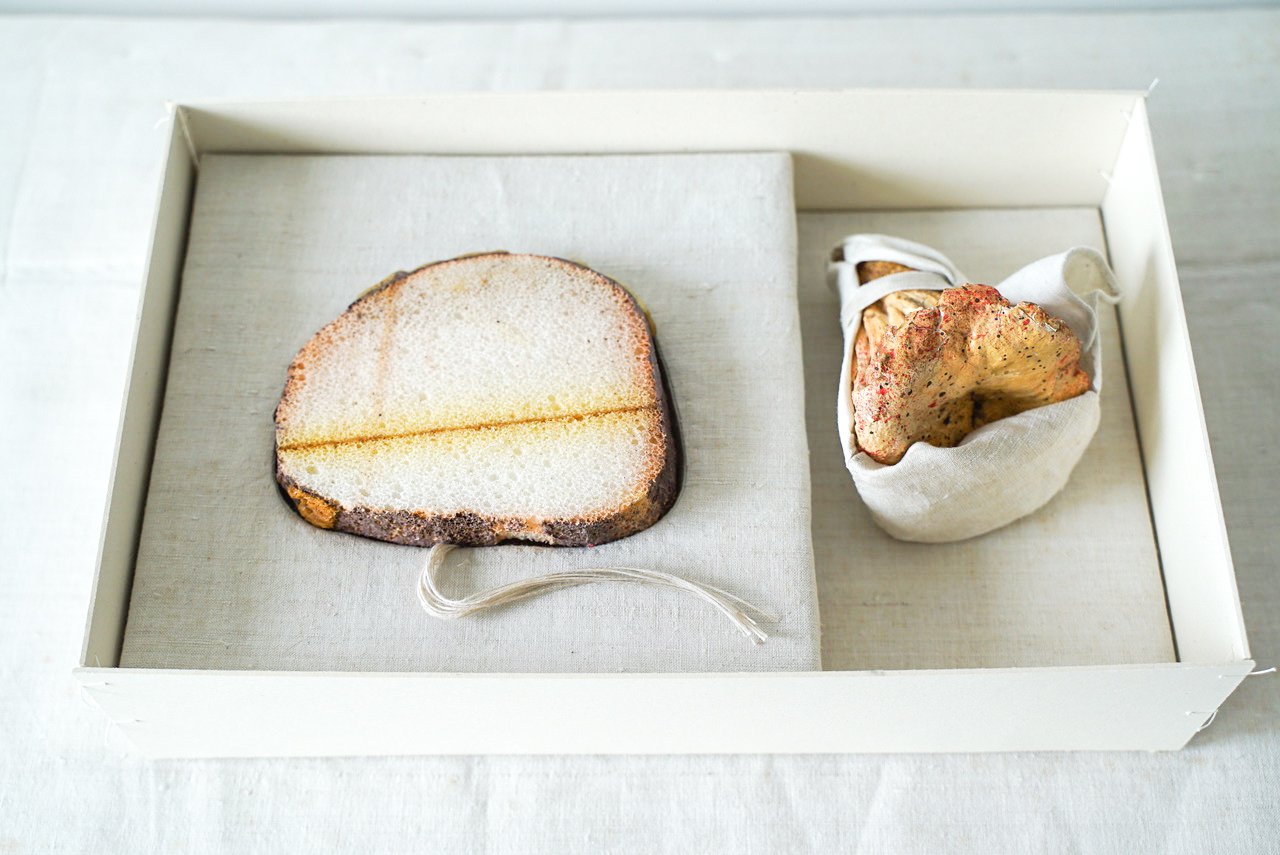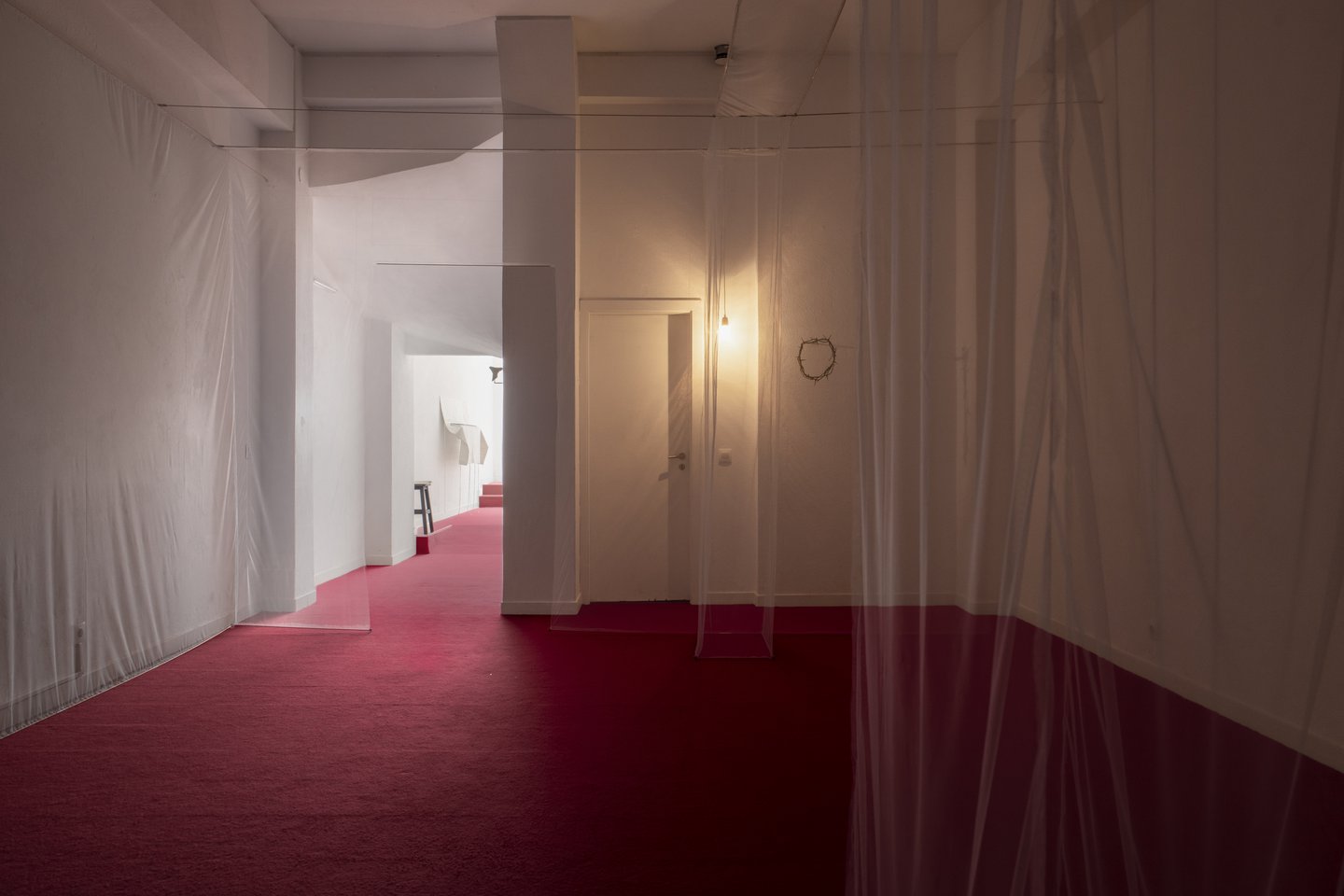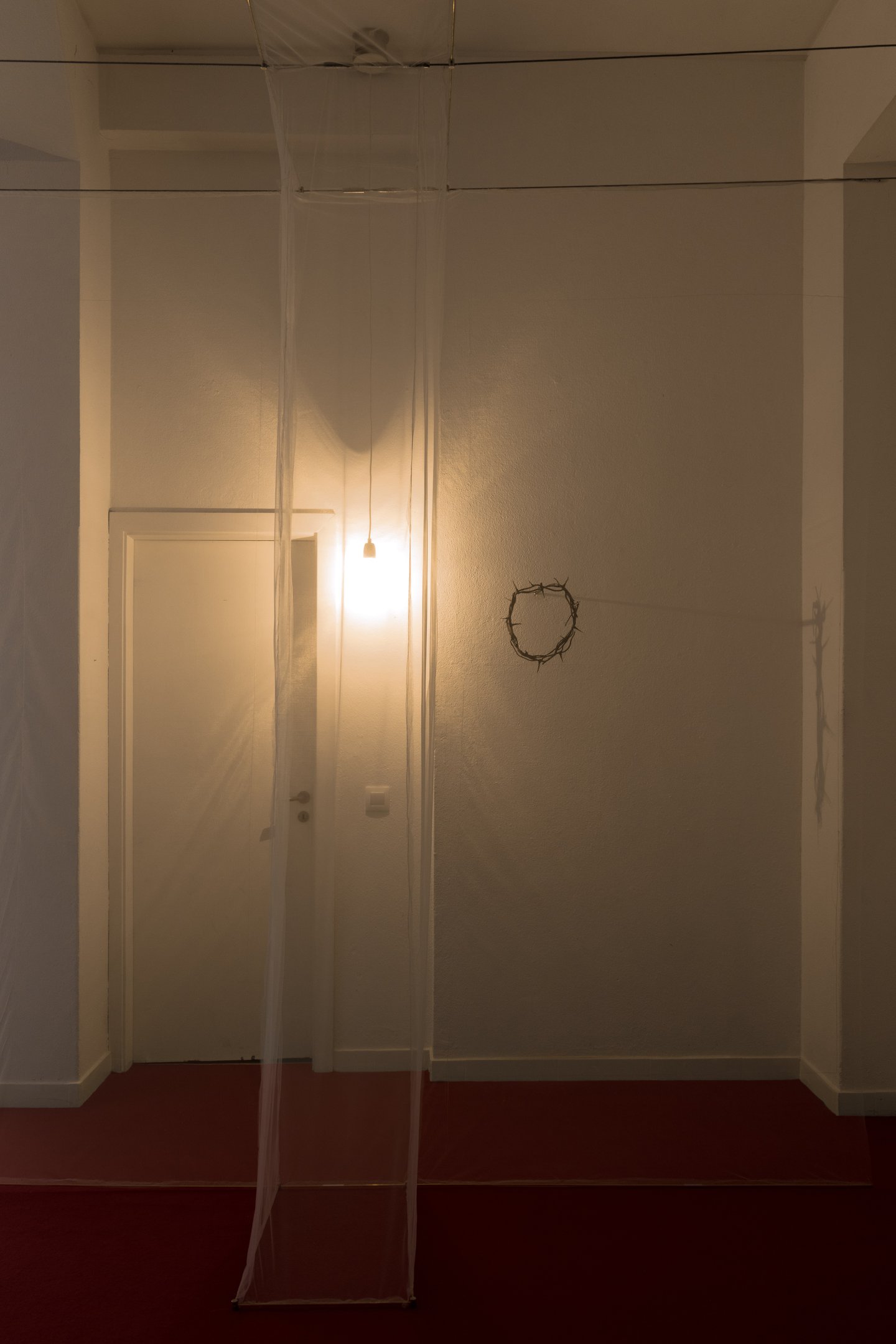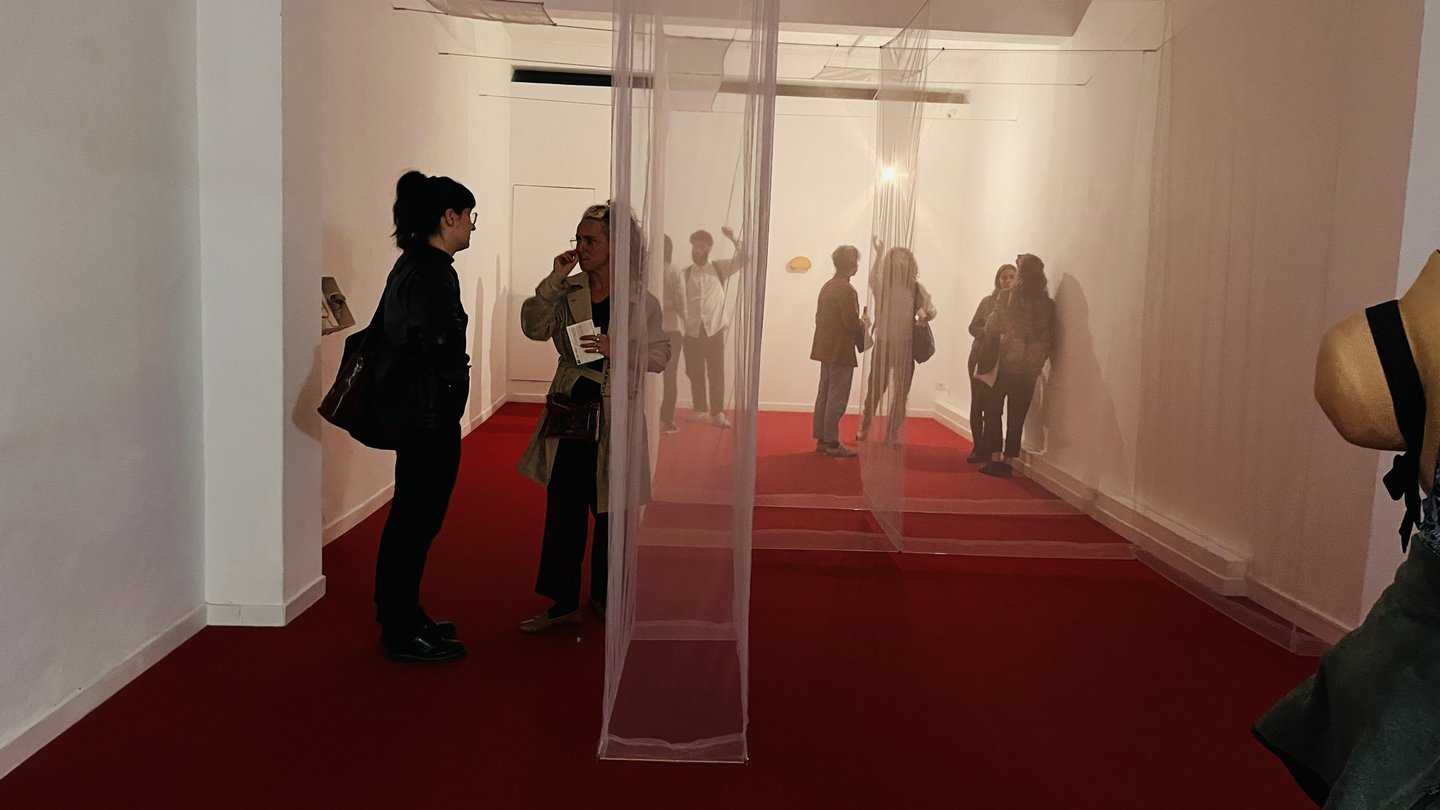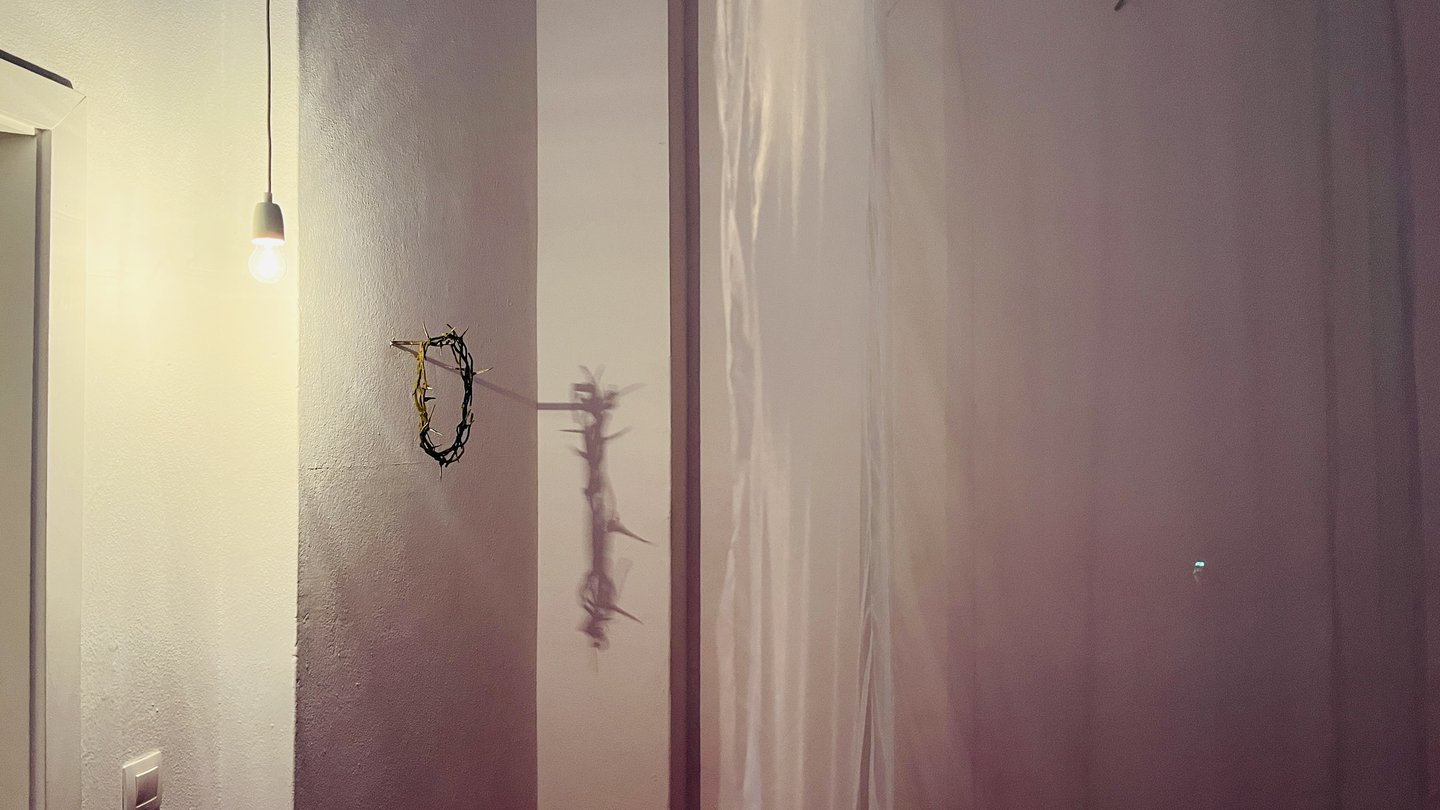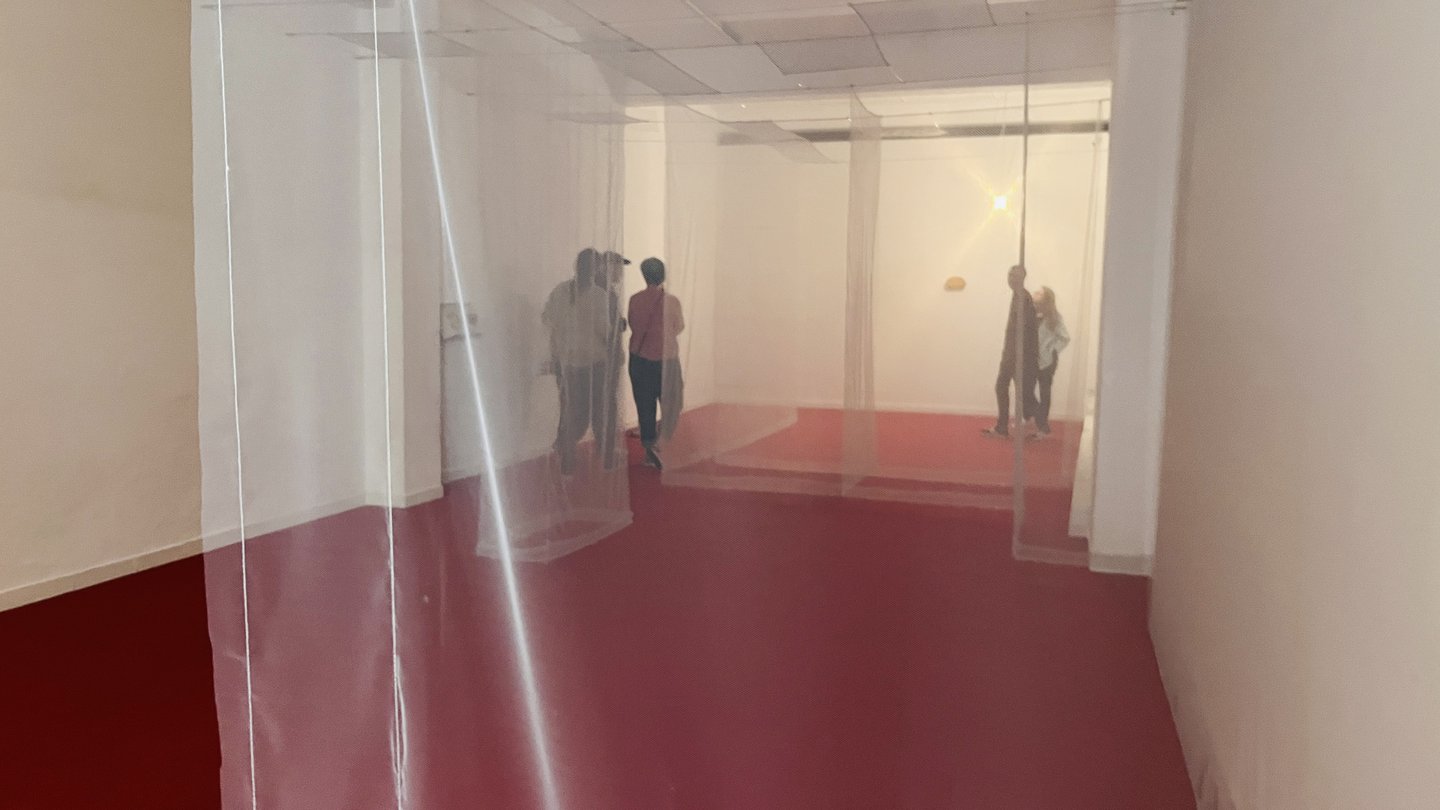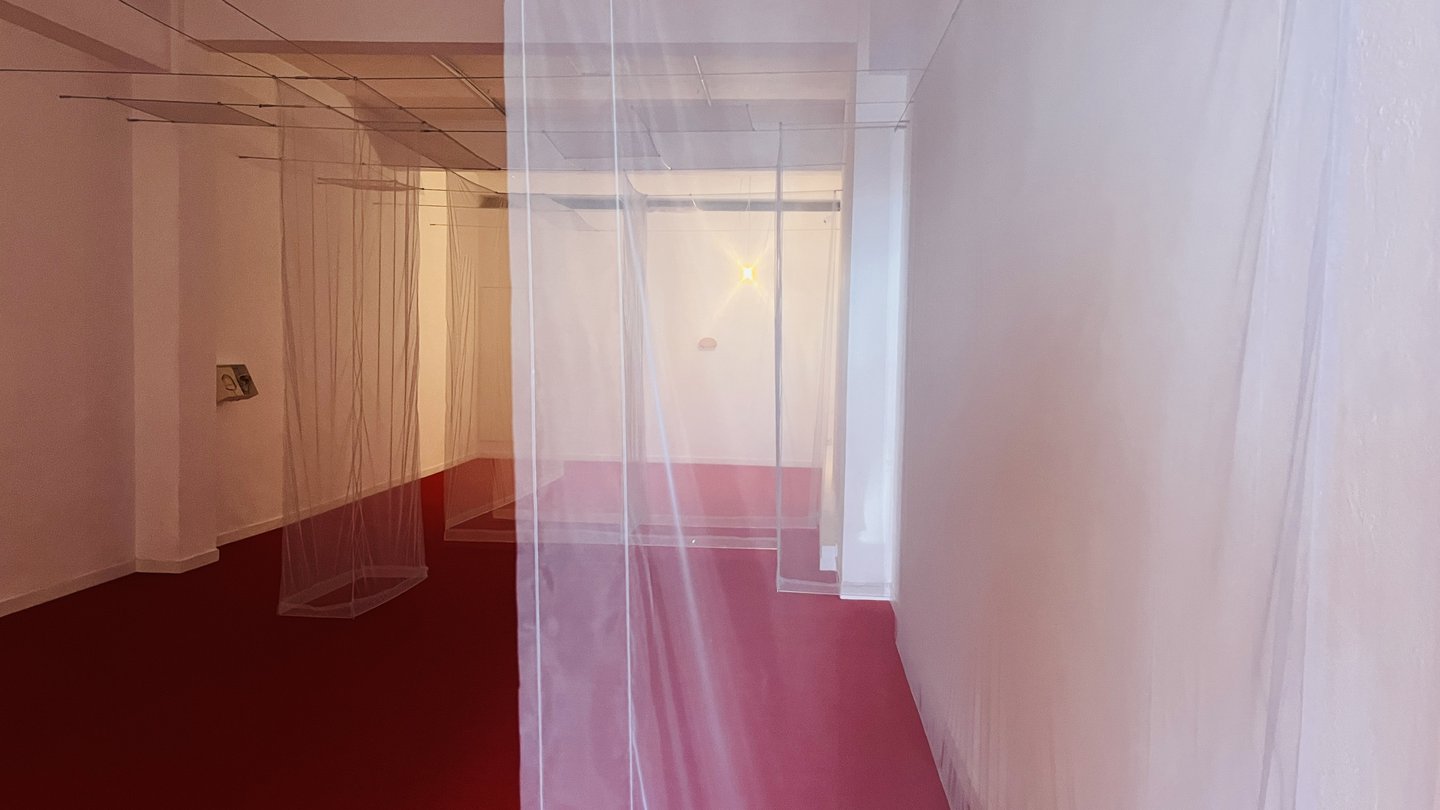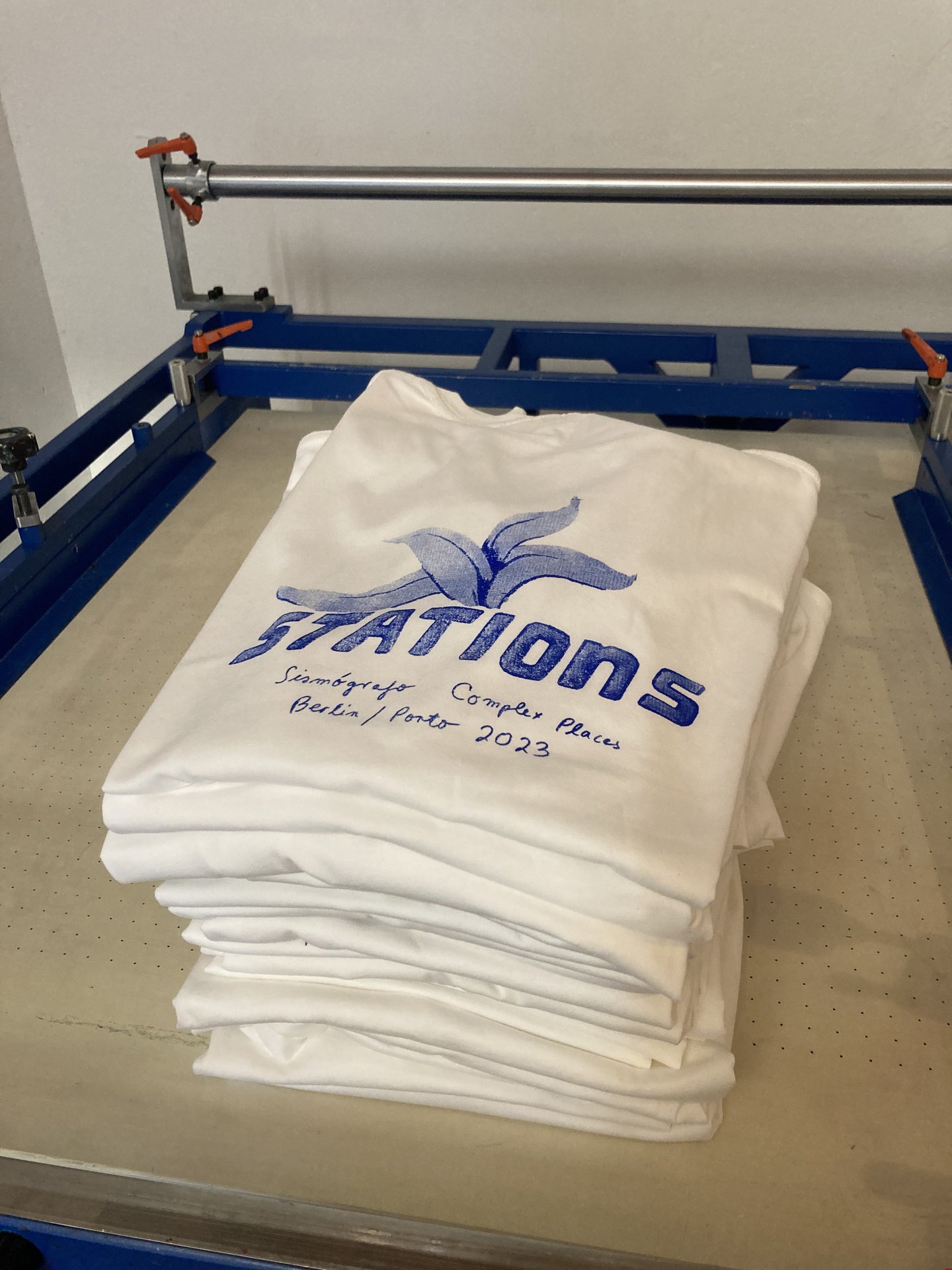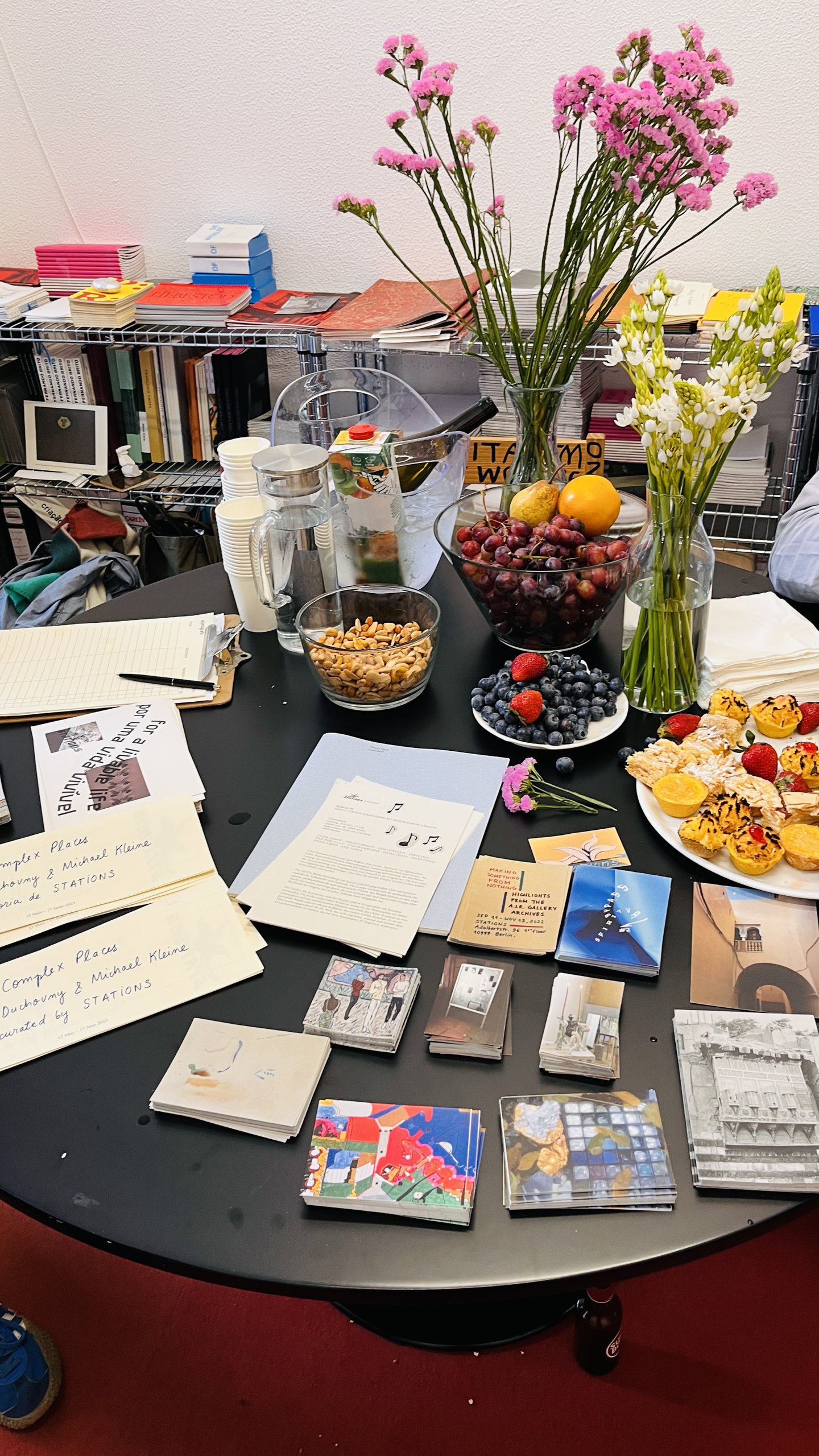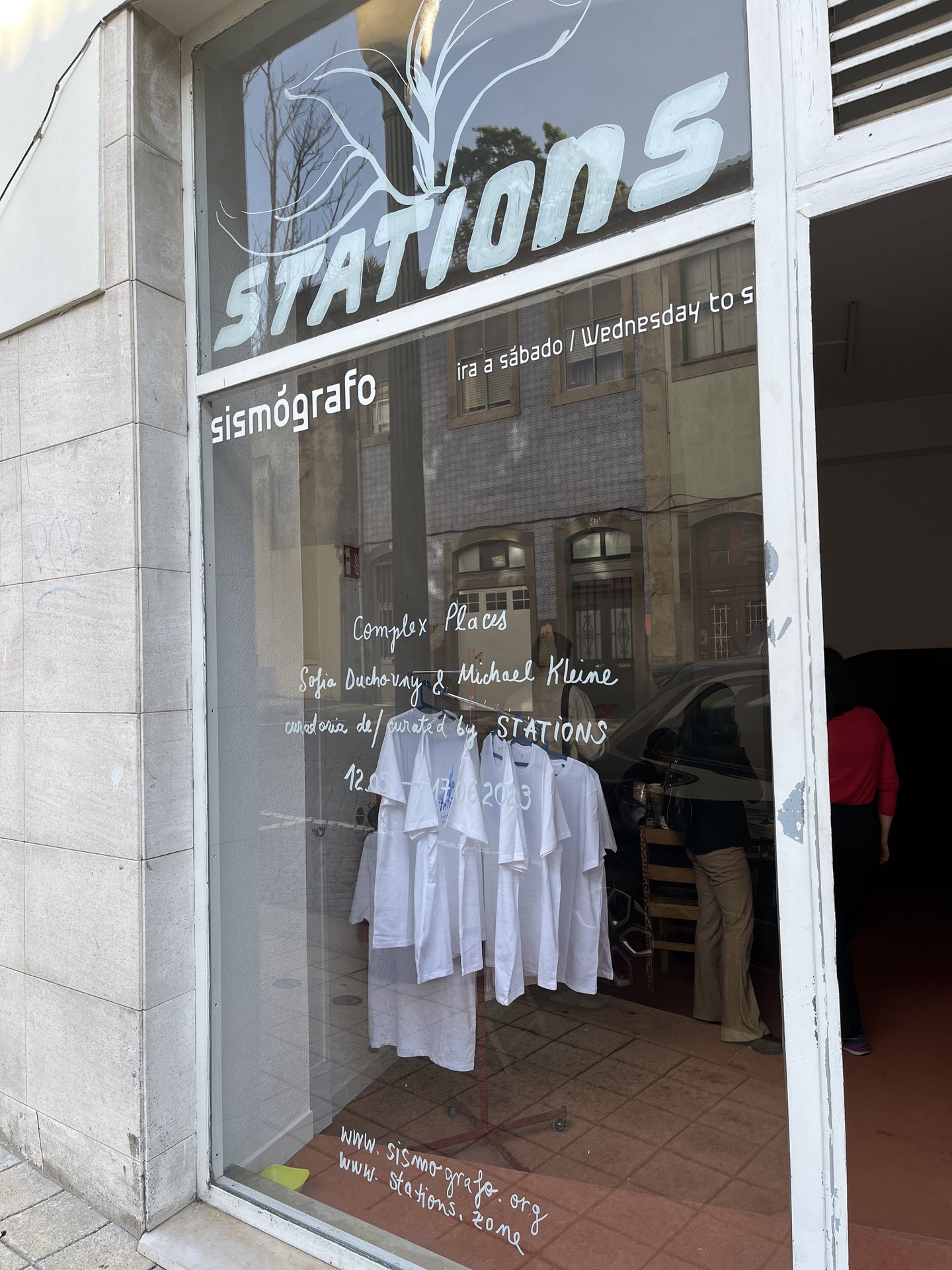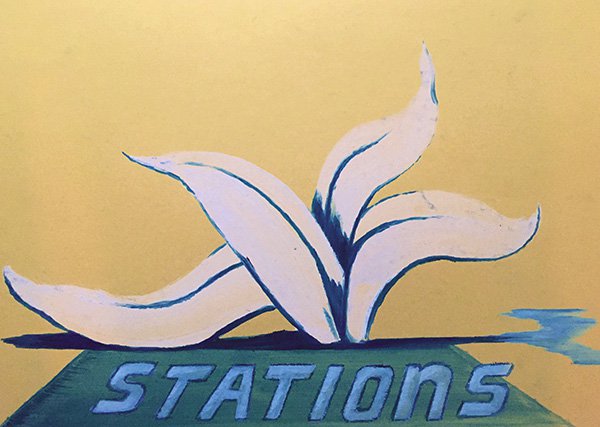Opening / Inauguração
Friday, 12 May / Sexta-feira, 12 Maio
18:30 – 21:00
Exhibition / Exposição
12 May – 17 June 2023 / 12 Maio – 17 Junho 2023
Wednesday to Saturday / Quarta-feira a Sábado
15:00 – 19:00
Sismógrafo
Rua da Alegria, 416
4000-035 Porto,
Portugal
How can the physical and immaterial aspects of a place be replicated, translated, or mediated to another context that has its own idiosyncrasies and specifics? When Sismógrafo invited us to organize an exhibition in their current space in Bonfim, we considered how we could address both the particularities and affinities of our respective spaces and practices. With both places and spaces in mind, we invited Berlin-based artists Sofia Duchovny and Michael Kleine to collaborate on this exhibition. In their individual practices, both artists’ works deal with notions of staging, performativity, theatricality, and explore specific conditions of reception and viewership.
As with any site – in this case, any exhibition site – its characteristics are fundamental to the practices, transactions, interventions, and objects that develop at or for it. Tightly woven and interdependent social and architectonic parameters influence our various routines considerably. Conversely, the individual and collective narratives we invest in a place shape it. A former piano store turned into an exhibition venue, Sismógrafo’s space is very distinct, with its light-flooded vestibule, the irregularly shaped hallway, the niches – and, most prominently, the bright red carpet – a reminder of the previous usage that became a permanent fixture and a decisive parameter for all the exhibitions that have been held here since. But more than just being a remnant from the piano store, the red carpet is a signifier of theatricality, display, performance. As such, it found a fitting, if at first glance unusual, use in the context of an exhibition space. From the outset, it signals the dynamic, reciprocal engagement between the viewers and objects present in this space. The exhibition conceived by Sofia Duchovny and Michael Kleine for Sismógrafo takes this transfer of energies as its premise.
The small objects carefully choreographed by Michael Kleine throughout the rooms of Sismógrafo are strange and ambiguous. The make-up of the life-sized slice of bread, the mushroom, or the crown of thorns bears a deceiving resemblance to their real-life counterparts. But upon closer inspection, their mimicry is exposed. Their realism turns out to be a masterfully crafted façade, and their deception twofold: they are neither the things they mimic, nor are they “real” works of art. A different kind of artifice describes them – they are theatrical props. If on stage these surrogates help suspend the spectator’s disbelief and convey veracity, here, removed from the network of theatrical signifiers, they hover between realities. But they’re only seemingly divested of their evocative powers, since the way in which Michael Kleine’s found objects “perform” in an exhibition space is not entirely dissimilar to the theater. His meticulous stagings of these objects effect a transformation of the architectural setting as well as a psychological activation of the latently involved visitor. Rather than helping transport a particular story, as in theater, here the props assume (mimic!) their new “role” as works of art. Peripatetic travelers from text to text, from context to context, Michael Kleine’s objects function as vehicles or screens for narratives that are shaped by the emotional and informational transactions between their environment and their viewers.
Similarly invested in the psychological activation of the viewer through visual and performative strategies, Sofia Duchovny’s expansive installation for Sismógrafo is a spectral replica of our space in Berlin. A translucent tulle pavilion hangs softly from a delicate pole structure that recreates the layout of our premises. The spatial outlines of STATIONS are transferred into a foldable, portable, temporary architecture, like a tent ready to be pitched at a different location. Here is a space tightly tucked into another space – visible and yet transparent and permeable; fragile and yet sheltering. By echoing an existing exhibition space, Sofia Duchovny’s makeshift pavilion reiterates the imitation game performed by Michael Kleine’s props. This doubly site-specific installation places the audience at its center and paradoxically intertwines two heterogenous places. By directing the spatial reenactment of movements that are physically possible in the Berlin space, the artist symbolically turns Sismógrafo’s visitors into visitors of STATIONS.
Together with Sofia and Michael we thought about the new audience we would be addressing in Porto. You, the reader of this text and perhaps a regular visitor to Sismógrafo, may not be familiar with the place at which STATIONS is located in Berlin, Germany.
As if it were a diagnosis, the letters ADHS (En: ADHD) are graffitied in slim red lettering at the top of the northern façade of the building complex called New Kreuzberg Center, in short NKC, where our premises are located. Besides us, there are many other larger and smaller businesses that have been there much longer than us: a Kurdish restaurant, a shoe repair shop, various Turkish bistros, a barber’s shop, a few artist studios and exhibition spaces, and the locally famous Café Kotti, to name just a few. And then there are the residents, regular tenants, who live in this building complex which straddles Adalbertstrasse, one of the arteries leading up to the bustling subway stop Kottbusser Tor. In fact, the entire area of which the NKC is an important component could be described as both plagued and fueled by restlessness and hyperactivity. It’s a heterogenous place in which opposites clash but also cohabit. If you zoom into the long open-air gallery on the south side of the building, which is accessible to passersby via a public staircase, you will find STATIONS between Café Kotti and the neighboring artist-run space Fächer. Despite the window fronts, our space seems quiet and almost meditative when the door is closed, but we usually let the soundscape of the busy street infiltrate the front room. In summer, our space is steeped in sunlight. The summer sun makes all the surrounding grime disappear and the gleaming blue sky illuminates the otherwise dingy yellows and grays of the building.
Our space, just like all others alongside the first-floor gallery and on the ground floor, was designed for commercial or public purposes. From the second floor up, there are residential apartments. The building is located in Kreuzberg, one of Berlin’s 12 districts. After World War II, when hundreds of thousands of homeless Berliners had to be provided with housing, an urban planning process was set in motion that rethought both architectural and social structures. The NKC was one such project in Kreuzberg. Built between 1969 and 1974, it cuts a semicircle through the former network of streets and buildings. Through the years, the social impact of this large building complex has had both highs and lows that reverberate to this day. Regardless of the socio-economic adversities it’s been grappling with (today, it’s not just the drug epidemic, but also a strong current of gentrification taking hold of the district), the area around the NKC has so far remained a lively place shaped by multicultural sociability and impregnated with wild energies.
We have taken you on this imaginary trip to Berlin-Kreuzberg in order to set a mental image of the place we come from. Now we are here, in Rua da Alegria 416 in Bonfim, Porto, at Sismógrafo. As you enter Sismógrafo‘s space for the last time before it moves to its new premises, Sofia Duchovny’s and Michael Kleine’s works invite you to mentally inhabit and explore the intersections and differences of various kinds of places simultaneously, and to add your own.
On the occasion of the show an edition of 20 silkscreen printed t-shirts are available.
Further information at www.sismografo.org
SOFIA DUCHVONY (1988, Moscow) lives and works in Berlin. She finished her studies in 2014 at the Staedelschule in Frankfurt am Main as master student of Monika Baer. In 2016, she participated in the Berlin Program for Artists. Her work has been exhibited at Künstlerhaus Balmoral, Kunsthalle Mannheim, Künstlerhaus Bremen, Kunsthalle Freeport, Kunsthal Aarhus, CONDO, New York, Kunstverein Göttingen, Künstlerhaus Bremen, Kunstverein Hannover, Between Bridges, and Kunstverein Braunschweig, amongst others. In 2016 she received a residency at HIAP in Helsinki, Finland.
MICHAEL KLEINE (1981, Lahr), lives and works Berlin, Germany. He received his MA in musical theater directing at the HfMT, Hochschule für Musik und Theater in Hamburg. His objects, installations, performances have been shown at the Bonner Kunstverein, KV – Verein für zeitgenössische Kunst Leipzig, Volksbühne Berlin, Schinkel Pavillon Berlin, Staatsoper Hamburg, Sammlung Klosterfelde Hamburg, Ruhr Triennale Bochum, Theater Basel, Museion Bozen, and the Biennale d’Arte di Venezia, among others. As a visual artist, he received a travel grant from Neue Kunst in Hamburg and was a fellow of the Akademie Musiktheater heute, Frankfurt am Main.
SISMÓGRAFO is an independent and self-managed space programmed by Salto no Vazio, a non-profit association born in 2013. Based in Bonfim, Porto, Sismógrafo offers continuous programming with visual arts exhibitions, performances, concerts, conferences, talks, workshops with artists, and an editions program. Our team is composed of Emídio Agra (Viana do Castelo, 1968), Rodrigo Camacho (Funchal, 1990), Susana Camanho (Porto, 1971), Pedro Huet (Porto, 1993), Maria João Macedo (Braga, 1986), Hernâni Reis Baptista (Vila do Conde, 1986), Sara Rodrigues (Porto, 1990), Rita Senra (Barcelos, 1993) and João Pedro Trindade (Aveiro, 1990).
Special thanks to: Katharina Marszewski & Offene Siebdruckwerkstatt SDW for the producing the editions.
//
Como é que os aspectos físicos e imateriais de um espaço podem ser replicados, traduzidos ou transpostos para um outro contexto com as suas próprias idiossincrasias e especificidades? Quando o Sismógrafo nos convidou para organizarmos uma exposição, no seu actual espaço no Bonfim, pensámos como poderíamos abordar tanto as particularidades como as afinidades dos nossos respectivos espaços e práticas. A pensar em ambos os lugares e espaços, convidámos para colaborarem nesta exposição os artistas Sofia Duchovny e Michael Kleine, radicados em Berlim. Nas suas práticas individuais, as obras de ambos os artistas lidam com as noções de encenação, performatividade e teatralidade, explorando as condições específicas da recepção.
As características de um espaço de exposição são fundamentais para as práticas, transacções, intervenções e objectos que nele ou para ele se desenvolvem. Os parâmetros sociais e arquitectónicos, fortemente entrelaçados e interdependentes, influenciam consideravelmente as nossas diferentes rotinas. Por outro lado, as narrativas individuais e colectivas que investimos num lugar dão-lhe forma. Uma antiga loja de pianos transformada em local de exposições, o espaço do Sismógrafo é muito particular, com o seu vestíbulo inundado de luz, o corredor de formas irregulares, os nichos e, sobretudo, o tapete vermelho intenso, que recorda a anterior utilização do espaço e que se tornou um elemento permanente e um parâmetro decisivo em todas as exposições que aqui se têm vindo a realizar. Mas, mais do que um vestígio da loja de pianos, o tapete vermelho remete à teatralidade, à exibição e à performance. Como tal, encontrou no contexto de um espaço de exposição uma utilização adequada, embora, à primeira vista, invulgar. Assinala, desde logo, o envolvimento dinâmico e recíproco entre os espectadores e os objectos presentes neste espaço. A exposição concebida por Sofia Duchovny e Michael Kleine para o Sismógrafo tem como premissa precisamente esta transferência de energias.
Os pequenos objectos cuidadosamente coreografados por Michael Kleine nas salas do Sismógrafo são estranhos e ambíguos. A apresentação da fatia de pão em tamanho real, do cogumelo ou da coroa de espinhos tem uma semelhança ilusória com as suas versões reais. Mas, após uma inspecção atenta, o seu mimetismo é revelado. O seu realismo acaba por ser uma fachada magistralmente trabalhada e o seu embuste duplo: não correspondem às coisas que imitam, nem são obras de arte “verdadeiras”. Gozam de um tipo diferente de artifício – são adereços teatrais. Se, no palco, estes dispositivos ajudam a suspender a incredulidade do espectador e a transmitir veracidade, aqui, retirados da rede de significantes teatrais, pairam entre realidades. Mas só são despojados dos seus poderes evocativos aparentemente, pois a forma como os objectos encontrados por Michael Kleine “actuam” num espaço de exposição não é totalmente diferente do teatro. As encenações meticulosas destes objectos provocam uma transformação do cenário arquitectónico, bem como uma activação psicológica do visitante implicado de forma latente. Em vez de ajudarem a transmitir uma determinada história, como no teatro, aqui os adereços assumem (mimetizam!) um novo “papel” como obras de arte. Viajantes peripatéticos de texto para texto, de contexto para contexto, os objectos de Michael Kleine funcionam como veículos ou ecrãs para narrativas moldadas pelas transacções emocionais e informativas entre o ambiente e os espectadores.
Também ela empenhada na activação psicológica do espectador através de estratégias visuais e performativas, a instalação expansiva de Sofia Duchovny para o Sismógrafo é uma réplica espectral do nosso espaço em Berlim. Um pavilhão de tule translúcido pende suavemente de uma delicada estrutura de varas que recria o traçado das nossas instalações. Os contornos espaciais do STATIONS são convertidos numa arquitectura dobrável, portátil e temporária, como uma tenda pronta a ser montada num local diferente. Trata-se de um espaço perfeitamente inserido noutro espaço – visível, ainda que transparente e permeável; frágil, ainda que acolhedor. Ao fazer eco de um espaço de exposição existente, o pavilhão artificial de Sofia Duchovny reitera o jogo de imitação efectuado pelos adereços de Michael Kleine. Esta instalação duplamente site-specific coloca o público no seu centro e, paradoxalmente, entrelaça dois lugares heterogéneos. Ao encenar a reconstituição espacial de movimentos que são fisicamente possíveis no espaço de Berlim, a artista transforma simbolicamente os visitantes do Sismógrafo em visitantes do STATIONS.
Juntamente com a Sofia e o Michael, tivemos em mente o novo público do Porto ao qual nos dirigimos. O leitor deste texto, quem sabe um visitante assíduo do Sismógrafo, poderá não estar familiarizado com o local onde o STATIONS está situado, em Berlim, Alemanha.
Como se de um diagnóstico se tratasse, as letras ADHS estão grafitadas a vermelho, em caracteres finos, no topo da fachada norte do complexo de edifícios chamado “New Kreuzberg Center”, abreviadamente NKC, onde se situam as nossas instalações. Para além de nós, há muitos outros estabelecimentos comerciais, grandes e pequenos, que ali se encontram há muito mais tempo do que nós: um restaurante curdo, uma sapataria, vários cafés turcos, uma barbearia, alguns estúdios de artistas e espaços de exposição, além do famoso Café Kotti, para citar apenas alguns. E depois temos os moradores, os inquilinos habituais que vivem neste complexo de edifícios situado na Adalbertstrasse, uma das artérias que conduz à movimentada paragem de metro Kottbusser Tor. De facto, toda a área, da qual o NKC é um componente importante, pode ser descrita como uma área perturbada e alimentada pela inquietação e hiperactividade. O lugar é heterogéneo, os opostos chocam, mas também coabitam. Se nos aproximarmos da longa galeria ao ar livre, no lado sul do edifício, acessível aos transeuntes através de uma escadaria pública, encontraremos o STATIONS entre o Café Kotti e o Fächer, um espaço vizinho gerido por artistas. Apesar das fachadas das janelas, o nosso espaço, quando a porta está fechada, é tranquilo e quase dado à meditação, mas normalmente deixamos que a paisagem sonora da rua agitada se infiltre na sala da frente. No Verão, o espaço é inundado pela luz do sol. O sol de Verão faz desaparecer toda a sujidade circundante e o céu azul brilhante ilumina os amarelos e cinzentos do edifício.
O nosso espaço, tal como todos os outros ao lado da galeria do primeiro andar e no rés-do-chão, foi concebido para fins comerciais ou públicos. A partir do segundo andar, os apartamentos são residenciais. O edifício situa-se em Kreuzberg, um dos 12 bairros de Berlim. Após a Segunda Guerra Mundial, quando centenas de milhares de berlinenses sem abrigo tiveram de ser alojados, desencadeou-se um processo de planeamento urbano que repensou as estruturas arquitectónicas e sociais. O NKC foi um desses projectos em Kreuzberg. Construído entre 1969 e 1974, traça um semicírculo sobre a antiga rede de ruas e edifícios. Ao longo dos anos, o impacto social deste grande complexo de edifícios conheceu altos e baixos que se repercutem até aos dias de hoje. Independentemente das adversidades socioeconómicas com que se tem debatido (hoje, não é apenas a epidemia da droga, mas também uma forte corrente de gentrificação que se apodera do bairro), a zona que envolve o NKC tem-se mantido um local animado, moldado pela sociabilidade multicultural e impregnado de energias rebeldes.
Realizámos esta viagem imaginária a Berlim-Kreuzberg para criar uma imagem mental do sítio de onde vimos. Agora estamos aqui no Sismógrafo, na Rua da Alegria 416, no Bonfim, Porto. Quando entramos no espaço do Sismógrafo, talvez pela última vez, antes da mudança para as suas novas instalações, deparamo-nos com as obras de Sofia Duchovny e Michael Kleine, que nos convidam a habitar mentalmente e a explorar, simultaneamente, as intersecções e diferenças de vários tipos de lugares e a acrescentar os que trazemos connosco.
Uma edição de 20 t-shirts impressas a serigrafia estará disponível durante a exposição.
Para mais informações: www.sismografo.org
SOFIA DUCHOVNY (Moscovo, 1988) vive e trabalha em Berlim. Concluiu os seus estudos em 2014 na Städelschule, em Frankfurt am Main, como aluna de Monika Baer. Participou, em 2016, no Programa de Berlim para Artistas. O seu trabalho foi exposto no Künstlerhaus Balmoral, Kunsthalle Mannheim, Künstlerhaus Bremen, Kunsthalle Freeport, Kunsthal Aarhus, CONDO, Nova Iorque, Kunstverein Göttingen, Künstlerhaus Bremen, Kunstverein Hannover, Between Bridges e Kunstverein Braunschweig, entre outros. Em 2016, realizou uma residência no HIAP em Helsínquia, Finlândia.
MICHAEL KLEINE (Lahr, 1981), vive e trabalha em Berlim, Alemanha. Concluiu o mestrado em direcção de teatro musical na HfMT, Hochschule für Musik und Theater, em Hamburgo. Os seus objectos, instalações e performances foram apresentados no Bonner Kunstverein, KV - Verein für zeitgenössische Kunst Leipzig, Volksbühne Berlin, Schinkel Pavillon Berlin, Staatsoper Hamburg, Sammlung Klosterfelde Hamburg, Ruhr Triennale Bochum, Theater Basel, Museion Bozen e Biennale d'Arte di Venezia, entre outros. Como artista visual, recebeu uma bolsa de viagem da Neue Kunst, em Hamburgo, e foi bolseiro da Akademie Musiktheater heute, Frankfurt am Main.
O SISMÓGRAFO é um espaço independente e autogerido, programado pela Salto no Vazio, uma associação sem fins lucrativos, nascida em 2013. Com sede no Bonfim, no Porto, o Sismógrafo oferece uma programação contínua com exposições de artes visuais, performances, concertos, conferências, conversas, oficinas com artistas e ainda um programa de edições. A nossa equipa é composta por Emídio Agra (Viana do Castelo, 1968), Rodrigo Camacho (Funchal, 1990), Susana Camanho (Porto, 1971), Pedro Huet (Porto, 1993), Maria João Macedo (Braga, 1986), Hernâni Reis Baptista (Vila do Conde, 1986), Sara Rodrigues (Porto, 1990), Rita Senra (Barcelos, 1993) e João Pedro Trindade (Aveiro, 1990).
Obrigado a: Katharina Marszewski & Offene Siebdruckwerkstatt SDW.
The exhibition is kindly supported by /
A exposição tem o apoio de
GOETHE-INSTITUT
